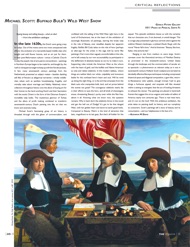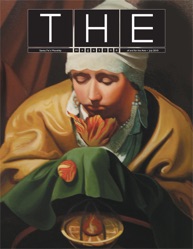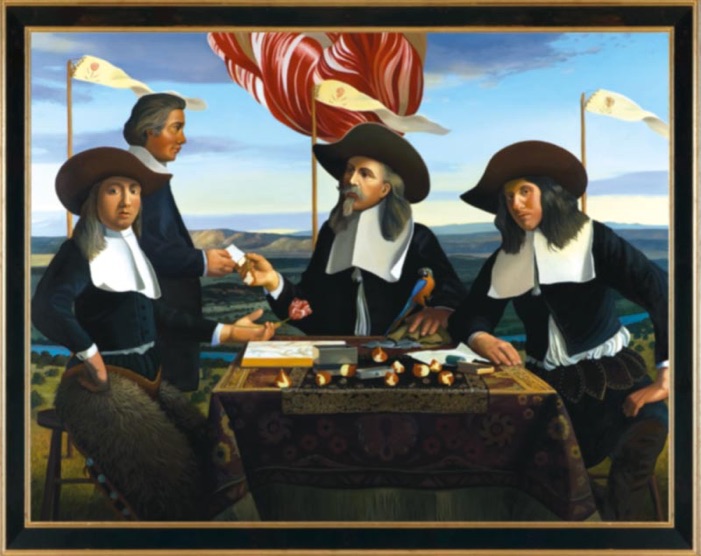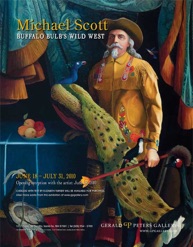THE Magazine July 2010

Buying beauty and selling beauty—what an idea!
—from the exhibition catalogue
In the late 1630s, the Dutch were going crazy
for tulips. Out of this mania came two most unexpected side
effects: the evolution of a mercantile-based middle class who
bought and sold flower futures, and an art just for them.
In their post-Reformation culture—minus a Catholic Church
to play the popish role of arts patron extraordinaire—paintings
in Northern Europe began to be made for, and bought by, the
well-to-do layperson eager to keep up with the Van der Joneses.
In fact, many seventeenth century paintings from the
Netherlands presented as subject matter—besides dazzling
still lifes of flowers as allegorical narratives—wholly middleclass
values such as spotless housekeeping, frugality, and
morality tales about marriage and fidelity. Relatively minor
collectors throughout history owe the allure of buying art for
their homes to the hard-working Dutch and their fascination
with the exotic Orient in the form of the Ottoman Empire’s
incredible tulip bulbs. The mysterious glamour of Turkey
and the allure of profit making combined to transform
seventeenth-century Dutch painting into the art that we
know and venerate today.
Michael Scott’s fascinating grasp of art history is
threaded through with the glitter of commercialism, and
conflated with the selling of the Wild West right here in the
Land of Enchantment, lies at the heart of this exhibition of
stunningly illusionistic oil paintings, starring the lovely tulip
in the role of Beauty, ever steadfast despite her apparent
fragility. Buffalo Bill Cody takes on the role of hero (perhaps
an alter-ego for the artist) in the saga told by some fifty
paintings; if he’s more than vaguely uncomfortable in the role,
we’re left uneasy by our own accountability as participants in
the defilement of absolute beauty as we try to make it ours.
Supporting roles include the American West as the whore
with the heart of gold, and the buffalo and Native American
as wise and valiant sidekicks. In this modern tableau, where
things are neither black nor white, culpability and innocence
battle for the confused hero’s heart and soul. Will he wind
up doing the right thing, or is the evil that emanates from the
black suits who manipulate bulb, land, and art prices behind
the scenes too great? The courageous sidekicks nearly die
in their efforts to save the hero, and all kinds of shenanigans
ensue, threatening Beauty’s purity even while she flies free,
above it all. Knowing what we know now, the question
remains: Why in heck don’t the sidekicks throw in the towel
and get the hell out of Dodge? It’s got to be that danged
West, with her golden heart and down-to-earth good looks.
Compared to Beauty, West’s is the kind of attraction that
lasts, magnificent to its last gasp. But that’s all fodder for the
sequel. This episodic exhibition leaves us with the certainty
that our characters are, if not doomed, in untold danger. This
is a tragic play presented in glorious carnival colors against the
sublime Western landscape, a stylized Moulin Rouge with the
moral “Never fall in love.” And its footnote: “Beauty, like love,
fades; only pictures last.”
Ranging in size from medium to extra large, Scott’s
canvases cover the theoretical territory of Manifest Destiny
as promoted in the nineteenth-century United States
through the landscape and the commercialism of secular art
as spectacle—a phenomenon as relevant today as it was in
seventeenth-century Holland. Scott’s subjects are narrated via
decidedly effective Baroque techniques including compressed
theatrical space and diagonal composition, a gem-like, returnto-
Renaissance color palette, enough trompe l’oeil to give
things a funhouse appeal, and exquisite still lifes situated
within a setting so energetic that the act of looking threatens
to exhaust the viewer. The paintings are placed in hand-built
frames that suggest the circus wagons and snake-oil sellers of
America nearly two centuries ago. There is real meat here,
and it’s not on the hoof. With this ambitious exhibition, the
artist takes on painting itself, its history, and our complicity
as consumers. Scott’s paintings tell a story of beauty and its
consumption—and our helplessness in the face of it.
—Kathryn M Davis




THEATRICALITY
My paintings are stage sets for conversation. I have one conversation with the work—the viewer has another
conversation with the work. Even though my paintings are conceptually driven, I don’t try to dictate how they
are to be seen. One of my favorite scenes from my boyhood is when Toto pulls the curtain back in The Wizard
of Oz and sees the wizard pulling all of the knobs in there, and Dorothy recognizes that the whole thing was an
illusion. I never forgot that. Painting is an illusion and I deal with that illusion as a conversation.
TIME
I try to make well-crafted paintings that convey a thought-out idea. There are a lot of nuances that occur within
that, and a lot of layers of information that happen. If I am clumsy in the process and don’t pull it off, then I fail
in what I’m trying to communicate. Because I create these bodies of work over a period of three to four years,
time is a factor. The trick is to have a concept that I can live with and develop over that period of time. Painting,
making art, is all about putting in the time.
WORDS
Our culture is layered and there’s a lot of information that comes at us. I find it very interesting to marry
typography and images, and particularly in this series where the work is like a poster or billboard, where
actual typography is incorporated to sell an idea, or an object, or a stage show.
A TULIP OR SNAKE OIL?
Buffalo Bill’s Buffalo Bulbs Wild West Show has to do with the illusion of beauty. It is like any circus—there are tents
and little booths, and each painting works as a sideshow; you go through the curtain to discover the show inside.
In this series, Buffalo Bill is selling beauty to America. He brings the tulip—the most austere, aloof, and perfect
flower—from Europe to America. If the tulip (beauty) can be sold, what could be the downside of that? If it’s a
lie, then the tulip (beauty) is snake oil. Of course, Buffalo Bill was marketing to a gullible audience—which is not
so different than any other market-driven idea about economics. This body of work can be seen as a metaphor
for the current art world, where prices are astronomical for questionable work.
ROLE OF THE GALLERY OR DEALER
In an ideal world, the dealer handles an artist’s career in all of its aspects. This means the artist’s livelihood, his
sales, and the collections where the work is placed. (In many respects that’s what I’m painting about in my
work—that kind of art-world illusion is the veil that Toto pulls back.) A lot depends on where you are in your
career. You can’t put a blanket on everything and say it’s always the same with all artists. It changes from artist
to artist and dealer to dealer, and it changes based on your hierarchy in the gallery and in the art world. And you
have to be comfortable with where you are in that hierarchy. And you have to be okay with the fact that you may
not sell that series, or you may not sell that piece, or you may not be on top this year—just because you were on
top ten years ago. There are a bunch of different varieties of vegetables in the art basket, and there’s no rhyme
or reason to it, but that’s what makes it interesting. The main thing is to just continue to do the work.
RULES OF THE ART GAME
Don’t follow trends—that’s number one. Number two, learn how to survive and still create work. Number
three would be to position your work with the right gallery for consistent representation and exposure. And
number four, know that people who buy your work do so mainly because they’re interested in who you are as
an artist—they buy because they want a piece of you. And you have to be willing to give that piece of yourself in
a gentlemanly fashion, while having your own limitations about how much of yourself you give. I believe that as
long as you have clear boundaries you’re fine.
AUTHENTICITY
Authenticity has to do with an inherent energy that’s contained within a work. If you’re putting energy into
a piece—if it’s authentic and true to its core—then it’s there. That doesn’t necessarily mean it’s going to be
experienced by everyone, but I guarantee that once authenticity and presence are in there, they’re always
in there.
THE REWARD
If I have a good day in the studio, it doesn’t get better than that. As far as my career goes, I put faith in the
process, and the work guides my career and achievements. I know that I will never know how good I am unless
I push myself. Bottom line—it’s all about dancing with life, and for me painting is the vehicle. That’s it! D
Michael Scott is just past
the halfway point in completing his new series of
paintings, Buffalo Bill’s Buffalo Bulbs Wild West Show.
The paintings explore beauty—or the illusion of
beauty—and can be appreciated as a metaphor
for the economics of the current art world. Scott’s
paintings are in numerous corporate and public
collections, including the Cincinnati Art Museum,
the New Orleans Museum of Art, and the Butler
Institute of American Art. Scott is included in a group
exhibition—Renegade Arts—opening on October
5, at the Museum of the American West, Autry
National Center, Los Angeles. In Santa Fe, Scott is
represented by the Gerald Peters Gallery.

